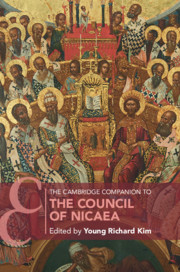Book contents
- The Cambridge Companion to the Council of Nicaea
- Cambridge Companions to Religion
- The Cambridge Companion to the Council of Nicaea
- Copyright page
- Dedication
- Contents
- Figures
- Contributors
- Acknowledgements
- Abbreviations
- 1 Introduction
- Part I Contexts
- Part II The Council
- 4 Hosting the Council in Nicaea
- 5 Reconstructing the Council of Nicaea
- 6 The Elephant in the Room
- Part III Outcomes
- Part IV The Aftermath
- Part V The Long Reception
- Appendices
- Bibliography
- Index
- References
4 - Hosting the Council in Nicaea
Material Needs and Solutions
from Part II - The Council
Published online by Cambridge University Press: 17 December 2020
- The Cambridge Companion to the Council of Nicaea
- Cambridge Companions to Religion
- The Cambridge Companion to the Council of Nicaea
- Copyright page
- Dedication
- Contents
- Figures
- Contributors
- Acknowledgements
- Abbreviations
- 1 Introduction
- Part I Contexts
- Part II The Council
- 4 Hosting the Council in Nicaea
- 5 Reconstructing the Council of Nicaea
- 6 The Elephant in the Room
- Part III Outcomes
- Part IV The Aftermath
- Part V The Long Reception
- Appendices
- Bibliography
- Index
- References
Summary
This chapter examines the physical surroundings and circumstances of the first ecumenical council at Nicaea. The first part summarizes what we know of the city of Nicaea, what it looked like in the early fourth century, and if it had the necessary infrastructure to host a large gathering. The chapter also considers why the council was moved to Nicaea from Ancyra as well as why Nicaea was favored over the nearby imperial capital of Nicomedia. The next part focusses on the location, character, and size of the venue of the council, the palace of Nicaea. After a more general discussion of the complex, the author attempts to shed light on the physical form of the hall in which the bishops gathered by reviewing the evidence for audience halls known from other imperial and private palaces. Both the possibility of the council taking place in a large basilica-like setting and an alternative of the bishops convening inside a rotunda are considered. Finally, there is a brief comparison of the setting of the Nicaean council and contemporary Christian meeting places.
Keywords
- Type
- Chapter
- Information
- The Cambridge Companion to the Council of Nicaea , pp. 65 - 89Publisher: Cambridge University PressPrint publication year: 2021



